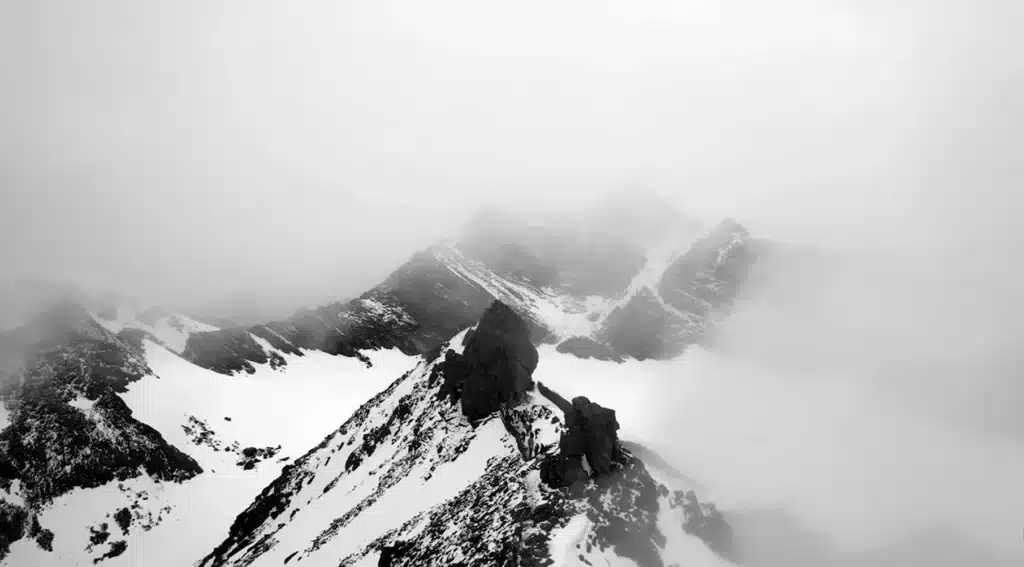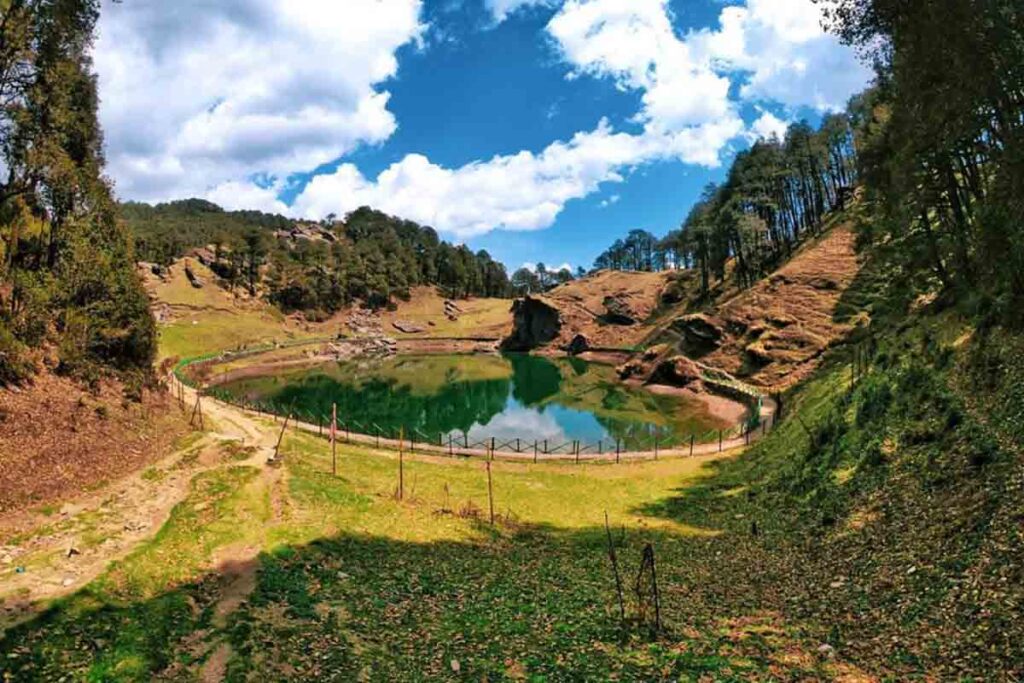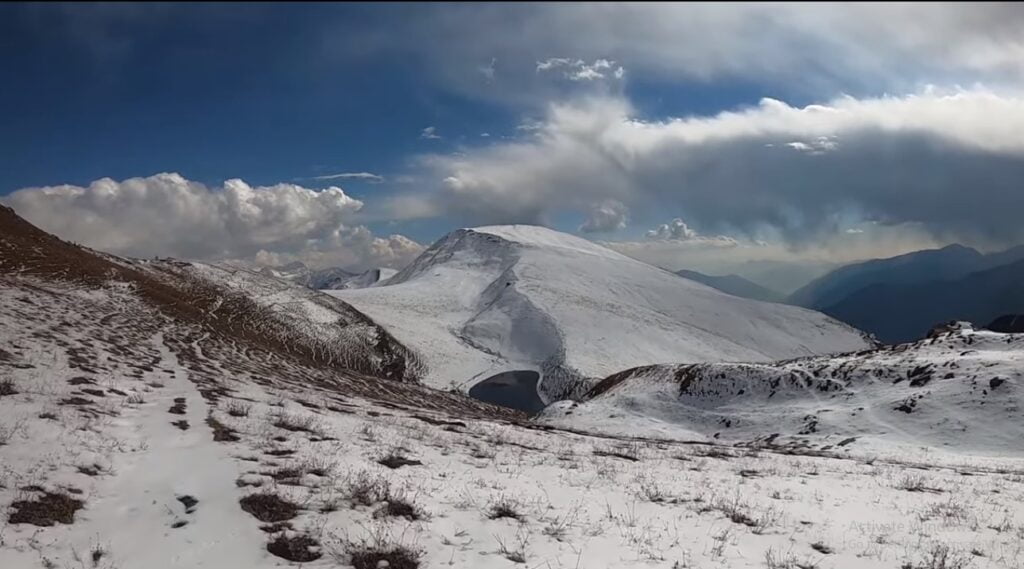The Shrikhand Mahadev Trek, situated in the pristine Kullu district of Himachal Pradesh, is not just a challenging high-altitude trek but a deeply spiritual pilgrimage. Considered one of the toughest treks in India, it culminates at a naturally formed 75-foot Shivling-shaped peak at an astonishing altitude of approximately 5,227 meters (17,150 feet). This journey is reserved for the physically and mentally prepared, offering a transformative experience for those who dare to undertake it.
Table of Contents
ToggleOverview and Spiritual Significance
Shrikhand Mahadev holds immense religious importance for Hindus, revered as one of Lord Shiva’s abodes. It is the third most significant peak among the “Panch Kailash” or “Five Kailashas,” a group of five sacred peaks associated with Lord Shiva, including Mount Kailash (first), Adi Kailash (second), Kinnaur Kailash (fourth), and Manimahesh Kailash (fifth).

Mythological tales abound, linking the peak to Lord Shiva’s hiding from the demon Bhasmasur and the Pandavas’ exile, with legends of Bhima leaving his marks on the rocks. Unlike many other Himalayan treks, the entire Shrikhand Mahadev journey must be completed on foot, involving steep ascents, treacherous rocky terrains, glacial crossings, and narrow ridges.
Best Time for Shrikhand Mahadev Trek
Due to extreme weather conditions, the Shrikhand Mahadev trek is accessible for a very limited window.
Peak Season: Mid-July to Mid-August/Early September offers the most stable weather conditions and clearer trails, with temperatures ranging from 0 degree C to 15 degree C. However, sudden weather changes, including rain or snow, are common.
Avoid: The monsoon season brings heavy rains, making the trail slippery and prone to landslides. Winters render the trek inaccessible due to heavy snowfall.
Difficulty and Preparation
The Shrikhand Mahadev trek is unequivocally difficult. It spans approximately 32 km one-way (64 km round trip) from Jaon village, featuring significant altitude gain, steep gradients, rocky moraine paths, and glacier crossings.
Physical Fitness
Physical fitness is Paramount: Begin rigorous preparation at least 2-3 months in advance. Do the following training:
Cardio Training
Focus on running, cycling, and stair climbing to build stamina and improve lung capacity.
Strength Training
Prioritise exercises for legs, core, and shoulders (e.g., squats, pull-ups, push-ups).
Endurance Building: Undertake long hikes with a weighted backpack (around 10-18 kg) to simulate trekking conditions.
Acclimatisation: Crucial for high-altitude treks, plan to spend a day or two at Jaon village or Thachdu to adapt to the altitude. Maintain a slow and steady pace during the trek, taking frequent breaks.

Typical Route and Itinerary (7 Days)
This is the itinerary if you are coming from Chandigarh or Delhi. The trek typically commences from Jaon village in the Kullu district.
Day 1: Chandigarh to Jaon Village (Drive)
Drive from Chandigarh to Jaon village (approx. 260 km, 8-9 hours). Jaon serves as the base camp for the trek.
Overnight stay in a guesthouse or homestay in Jaon.
Day 2: Jaon to Singhad to Thachdu (Trek – 12-17 km)
The trek begins from Jaon.
Jaon to Singhad (5 km): A relatively easy stretch to the first base camp, Singhad, where basic food services are available.
Singhad to Thachdu (7-12 km): A challenging uphill trek through dense forests, known as ‘Dandi-Dhaar’ due to its steep, approximately 70-degree incline. You’ll encounter lush deodar trees and streams.
Overnight stay in tents at Thachdu (approx. 11,300 ft).
Day 3: Thachdu to Bheem Dwar via Kali Ghati (Trek – 10-11 km)
Thachdu to Kali Ghati (3 km): A steep uphill climb to Kali Ghati, believed to be the abode of Goddess Kali. On a clear day, the Shiva-Lingam at Shrikhand Mahadev is visible from here.
Kali Ghati to Bheem Talai (1 km): A downhill stretch.
Bheem Talai to Kunsa Valley (3 km): A beautiful green valley adorned with Himalayan flowers.
Kunsa Valley to Bheem Dwar (3 km): Arrive at Bheem Dwar (approx. 13,600 ft), believed to be where Bhima attempted to build stairs to heaven. This is a major campsite.
Overnight stay in tents at Bheem Dwar.
Day 4: Bheem Dwar to Shrikhand Mahadev Summit and Return to Bheem Dwar (Summit Day – approx. 14 km round trip)
This is the most demanding day. Start very early in the morning.
Bheem Dwar to Parvati Bagh (2 km): Reach Parvati Bagh (Parvati’s garden), known for the rare and sacred Brahma Kamal (Saussurea obvallata) flower.
Parvati Bagh to Nain Sarovar (2 km): Proceed to Nain Sarovar (approx. 14,500-15,000 ft), a holy glacial lake. The Shrikhand Mahadev peak is clearly visible from here.
Nain Sarovar to Shrikhand Mahadev Peak (3 km): Embark on a strenuous climb through rocky terrains to the summit, where the 75-foot Shivlingam is situated. A mountain for Lord Kartikeya is also present behind the main Shiva mountain.
Spend time at the summit for Darshan (sacred viewing) and spiritual reflection.
Descend back to Bheem Dwar for an overnight stay.
Day 5: Bheem Dwar to Thachdu (Descent)
Descend back from Bheem Dwar to Thachdu via the same route.
Overnight stay in tents at Thachdu.
Day 6: Thachdu to Jaon Village (Descent)
Complete the descent from Thachdu back to Jaon village.
Overnight stay in a guesthouse/homestay in Jaon.
Day 7: Jaon to Chandigarh (Drive)
Drive back to Chandigarh/Delhi, concluding the trek.
Nain Sarovar Lake: The Sacred Tear of Parvati
Located just above the Parvati Bagh campsite, Nain Sarovar is a pristine glacial lake at approximately 14,500 to 15,000 feet. Its eye-like shape and crystal-clear, icy waters are fed by surrounding glaciers.
Religious Significance
According to popular mythology, Nain Sarovar was formed from the tears of Mata Parvati. Legend says she wept here while waiting for Lord Shiva, who was deep in meditation on the Shrikhand peak. For pilgrims, a holy dip in its frigid waters is a crucial ritual before the final ascent, believed to purify the soul and spiritually prepare them for Lord Shiva’s darshan. The surrounding area, especially Parvati Bagh, is also famed for the rare and sacred Brahma Kamal flower, further enhancing the spiritual aura of this revered spot.
Essential Gear and Packing List
Packing light yet smart is vital for this challenging trek.
Clothing (Layering System):
Thermal wear (top and bottom)
Fleece jackets (2)
Full-sleeve quick-dry t-shirts (2-3)
Trekking pants (2)
Windproof and waterproof outer jacket
Down jacket (for summit night)
Woollen cap, neck warmer, waterproof gloves
Woollen socks (3-4 pairs), normal socks (6-7 pairs)
Sun cap
Footwear:
Sturdy, waterproof trekking shoes with excellent ankle support and grip (mandatory)
Camp sandals/floaters for campsite use
Backpack & Daypack:
Main Backpack: 45-60 litre capacity (for main luggage, can be carried by porters/mules if hired)
Daypack: 15-20 litre capacity (for summit day essentials)
Rain cover for both backpacks, Sleeping Gear:
Sleeping bag rated for sub-zero temperatures (if camping independently)
Sleeping mat
Trekking Equipment:
Trekking Poles: Highly recommended for stability and reducing knee strain (mandatory)
Headlamp/Torch with extra batteries
Health & Safety:
Personal First-Aid Kit: Pain relievers, antiseptic, bandages, blister plasters, altitude sickness medication (consult doctor), ORS, personal medications.
Sunscreen (high SPF), lip balm with SPF, UV-protected sunglasses.
Hand sanitiser, wet wipes, toilet paper.
Water bottle/hydration pack (minimum 2 litres capacity).
Electrolyte packets/energy drinks.
Food:
Energy bars, dry fruits, chocolates, and nuts for quick energy boosts.
Documents:
Valid Government-issued ID (original and copy)
Colored passport-size photos
Medical certificate (if required by the tour operator)
Trek registration details
Travel insurance (highly recommended)
Miscellaneous:
Power bank for charging electronics
Small quick-dry towel
Reusable trash bag (follow Leave No Trace principles)
Permits and Registration
While there’s no official “permit cost,” registration with local authorities is mandatory for security. The Kullu District Administration and Shrikhand Mahadev Yatra Trust oversee registration. Local village committees may collect a small fee (₹100-₹500) for trail maintenance. Tour operators typically handle registration.
Accommodation and Food
Jaon Village: Basic guesthouses and homestays are available.
During Trek: Tented accommodations are set up at campsites like Singhad, Thachdu, and Bheem Dwar, providing basic shelter.
Food: Basic vegetarian meals (dal-rice, roti, vegetables) and hot beverages are available at campsites. Independent trekkers should carry sufficient dry rations.
Major Challenges of the Trek
High Altitude Sickness (AMS): A significant risk. Symptoms include headache, nausea, and dizziness. Proper acclimatisation, slow ascent, and hydration are crucial.
Steep and Rugged Terrain: The trail features relentless ascents, rocky patches, boulders, and narrow ridges.
Glacier Crossings: Trekkers must navigate slippery snow patches and glaciers, requiring extreme caution.
Unpredictable Weather: Sudden changes in weather (rain, snow, strong winds) are common at high altitudes.
Limited Facilities: Amenities beyond Jaon are very basic. Mobile network coverage is sparse or non-existent for most of the trek.
Demanding Physical and Mental Endurance: The trek pushes the limits of physical capability and mental fortitude.
Safety Considerations and Tips
Trek in Groups: Never trek alone. Join experienced friends or an organised group with certified guides.
Hire a Local Guide: Highly recommended due to the strenuous nature, glacier walks, and unpredictable weather. Local guides possess invaluable knowledge of the route, weather patterns, and emergency procedures.
Acclimatise Properly: Do not rush the ascent. Allocate dedicated acclimatisation days.
Stay Hydrated: Drink ample water throughout the day to prevent dehydration and aid acclimatisation.
Pace Yourself: Walk at a steady, comfortable pace and take frequent short breaks.
Follow Trekking Etiquette: Respect nature, avoid littering, and adhere to local guidelines.
Medical Check-up: Get a thorough medical examination before attempting the trek.
Emergency Contacts: Carry a list of important contacts, including local rescue teams or tour operators.
Communication: As mobile networks are unreliable, consider a satellite phone or walkie-talkie if trekking independently.
Listen to your body: If you experience severe AMS symptoms, descend immediately.
How to Reach Shrikhand Mahadev Trek Base Camp
Village (Jaon) is the base camp from where the Shrikhand Mahadev Trek starts. This is how you can reach this village :
By Air: The nearest major airports are at Bhuntar Airport (Kullu), approximately 165 km from Jaon and Chandigarh Airport (approx. 260 km). There is also a small airport at Shimla. You can find out the details of flights to these cities. From there, either hire a cab or take an HRTC bus to Jaon village. HRTC has excellent bus service in the entire state of Himachal Pradesh.
By Train: The nearest major railway stations are Shimla or Chandigarh. From there, take a bus or hire taxi.
By Road: Jaon Village is at a distance of approximately 165 km from Shimla, the nearest major city. Buses and taxis are readily available. From Shimla, take a bus or taxi to Rampur (130 km). Those coming from Delhi and beyond, there are direct bus service from ISBT Kashmiri Gate, Delhi to Rampur. Get down at Rampur and take another bus or taxi to reach Nirmand (17 km), followed by a local taxi or bus to Jaon (20 km approx). This is how to reach the base camp for the Shrikhand Mahadev trek.
To Sum Up
The Shrikhand Mahadev Trek is a profoundly transformative journey, blending intense spiritual devotion with extreme adventure. With diligent planning, thorough preparation, and deep respect for the formidable Himalayan environment, trekkers can experience a safe and immensely rewarding pilgrimage to the sacred abode of Lord Shiva.


